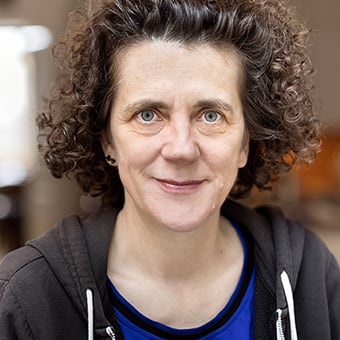
Olga Neuwirth
Equivocalities, shiftings and fractures
Notes on the music of Olga Neuwirth
by Stefan Drees
She has no business with the unambiguous. No: the works of Austrian composer Olga Neuwirth seethe incessantly. Sounds reel from one episode to another, gathering up into different aggregate states, before breaking out of them once more. Many tiny events culminate in turbulent sound units and nervous, glimmering textures that are constantly changing shape and volume. In the process, the formal structures of the music resist the conventions of narrative progression: instead of purposeful continuity, there is an opaque sequence of proliferating sound states, continual interruptions and abrupt breaks. The aborted schemes and changes of direction are also rich in contrast, and from the background, there emerge ever evolving and contrasting perspectives of sound.
The confusing effect of Olga Neuwirth’s works is founded on shiftings and deformations. Deviations from a norm considered traditional are a means for the composer to develop the elements of an intensely personal musical language. This begins with the very specific use of spatially deformed sounds and the manipulation of instrumental sound. Its conclusion is an equality between electronic or visual elements and the basic musical parameters as they become artistic means of equal value. Thus Olga Neuwirth’s art is an extremely artificial one and allows much room for the hybrid. This is not only due to the way she strips well-known sound matter of its associations with beauty – a beauty which may have been a misconception anyway, created by the music industry – using diverse preparation methods and playing techniques to allow a transparency which illuminates the strata lying beneath. It has also to do with the natural way in which she integrates various and often extremely heterogenous materials into her music and uses them as components for elaborated states of sound.
The virtuosity with which Olga Neuwirth deals with those processes accompanies the pleasure of confusing the listener’s habits of perception and confronting them with the unfamiliar. In this sense, listeners are lured out of their shell and encouraged to achieve an active realisation of the sounding music. Whether we think of locus …doublure …solus, where the constantly changing moods of the music accompany the soloist and his sound shadow over the different stages of the piece, or of ecstaloop, where the overall sound is dominated by effervescent whirls of music and language, or of torsion: transparent variation, where abrupt architectonic fissures and fractures question the familiar: such processes always lead to situations in which music turns an unexpected direction, resisting the listener’s expectations. The equivocality of all those gestures of language suggests that eventually below the surface of Olga Neuwirth’s music there are deep abysses. Therefore the element of catastrophe, of the shifting towards unfamiliar regions with all its consequences, is the ground colour of her works and the thread which links them together.
© Stefan Drees
(translation: Andreas Goebel)
